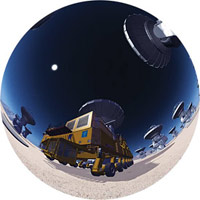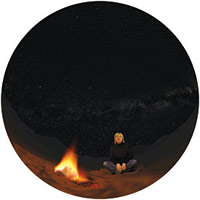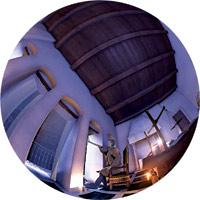For the Press
As part of a wide range of education and public outreach activities for the International Year of Astronomy 2009, the European Southern Observatory (ESO) has collaborated with the Association of French-speaking Planetariums (APLF) and other partners in Europe to produce a new planetarium show, 30 minutes in length, and centred on the global ground-based astronomical Atacama Large Millimeter/submillimeter Array (ALMA) project.
The ALMA Planetarium Show is an official part of the French activities for IYA 2009 and represents a unique chance for planetariums to celebrate the international year.
The emphasis of the new planetarium show is the incomparable scientific endeavour that the ALMA project represents. Edited by world experts Mirage3D, the show includes unique animations and footage, leading the viewer from the first observations by Galileo, 400 years ago, to the world of modern astronomy, moving from the optical wavelength domain to explore the millimetre-wave view of the Universe, and leaving light-polluted cities for unique settings in some of the highest and driest places on Earth. A young woman astronomer guides the public throughout the story.
The show is currently available in French and English. Several other language versions are in preparation: German, Italian, Spanish and Chilean Spanish. Further languages are being planned: Danish, Dutch, Greek, Japanese, Portuguese, and Brazilian Portuguese.
The show will be available in 3 different formats: full dome video, classical with video windows, and classical. It will be available to all planetariums worldwide for a small fee, depending on the type and the size of the planetarium, to cover basic costs.
About the producers
ESO is the European Southern Observatory. Created in 1962, ESO provides state-of-the-art research facilities to European astronomers and astrophysicists and is supported by Austria, Belgium, the Czech Republic, Denmark, Finland, France, Germany, Italy, the Netherlands, Portugal, Spain, Sweden, Switzerland and the United Kingdom. Several other countries have expressed a strong interest in joining the organisation.
Whilst the Headquarters (comprising the scientific, technical and administrative centre of the organisation) are located in Garching near Munich, Germany, ESO operates, in addition to the Santiago Centre, three observational sites in the Chilean Atacama desert. At La Silla, 600 km north of Santiago de Chile and at 2400 m altitude, ESO operates several medium-sized optical telescopes. The Very Large Telescope (VLT) is located on Paranal, a 2600 m high mountain south of Antofagasta, which also hosts the VLT Interferometer and two survey telescopes, the VST and VISTA. The third site is the 5000 m high Llano de Chajnantor, near San Pedro de Atacama. Here a new submillimetre telescope (APEX) is in operation, and a giant array of 12 m submillimetre antennas (ALMA) is being constructed in collaboration with North America, East Asia and Chile.
ESO is currently engaged in design studies for an Extremely Large optical/near-infrared Telescope, the E-ELT.
Since 2001, APLF has built up experience producing unique planetarium shows at the European level. The APLF, born in 1984 but officially created in 1989, coordinates the operations of about 30 large planetariums (6 to 20 metres) plus about 100 smaller ones, accounting for a total of about 1.3 million visitors per year in France. As a member of the International Planetarium Society, the APLF has also established close links with planetariums from many other countries.
In 2001, the APLF produced, in collaboration with the French space agency CNES, a show about the Earth seen from Space, while in 2002, with ESO, it made a very successful show for the 40 year anniversary of ESO, about the “Mysteries of the Southern Sky” celebrating the work of the Very Large Telescope (VLT), Europe’s flagship in ground-based optical/infrared astronomy. In each case, around 40 planetariums presented the shows, and the 2002 show about the VLT is still presented in some of these planetariums.
About the Editor
Mirage3D is a 3D animation studio focussing on large format cinematic experiences. It specialises in the creation of full dome video planetarium shows, as well as HD video productions. Full dome video shows immerse the audience in a true 360 degrees projected computer generated virtual environment. The Mirage3D productions are popular scientific shows that appeal to a large general audience. They are motivational journeys through time and space, covering a wide range of natural sciences. Mirage3D full dome productions include “Origins of Life” and “Dawn of the Space Age”. |
Click on the images below to download them in high resolution:



More images are available on the downloads page
|